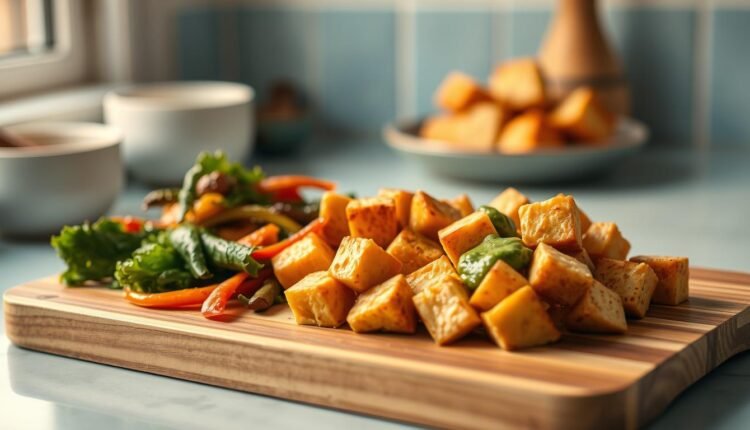High Protein Lunch Prep Tofu For Plant Based Nutrition
Get ready to prep ahead with our high protein lunch prep tofu recipes. Perfect for busy professionals seeking nutritious, grab-and-go meals.
As a chef and mom of two, I’ve learned that the secret to sustainable meal planning lies in ingredients that multitask. Enter the humble block sitting in your fridge right now—a blank canvas waiting to transform into crispy bites, savory bowls, or zesty wraps.
This guide focuses on building nutrient-packed meals around a versatile staple. You’ll discover how simple techniques—like marinating and baking—can turn basic components into satisfying dishes ready for hectic weeks. Whether you’re new to batch cooking or looking to refresh your routine, these strategies work with standard kitchen tools and realistic timeframes.
We’ll explore:
- Why this ingredient shines in make-ahead meals
- Essential flavor pairings (hello, garlic and ginger)
- Storage hacks to keep textures perfect for days
No complicated steps or fancy equipment required—just practical methods I’ve tested through years of helping families create meals that actually get eaten. Let’s build your blueprint for stress-free lunches that fuel busy days.
Plant-Based Protein and Tofu
Ever wonder how to keep your meals exciting and nutritious without spending hours in the kitchen? Let’s start with the basics: plant-based protein isn’t just a trend—it’s a smart way to fuel your body. Unlike animal sources, options like soybeans and lentils deliver fiber alongside essential nutrients, creating meals that satisfy longer.
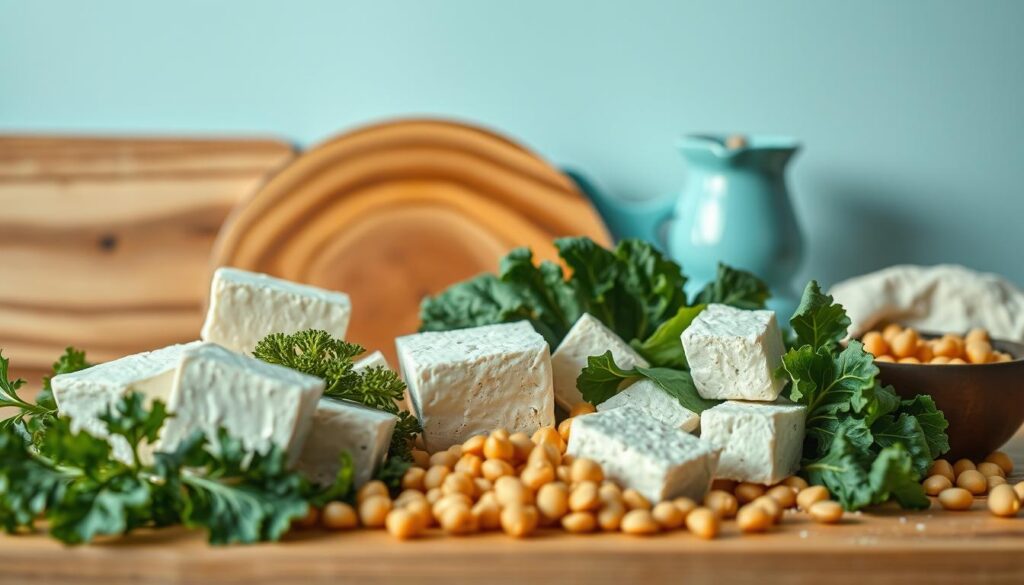
Tofu shines here. Made from soy, it’s a complete protein containing all nine amino acids your body needs. A half-cup serving packs 10 grams of protein and 20% of your daily calcium—stats that rival Greek yogurt. Plus, its neutral taste acts like a flavor sponge, soaking up spices or marinades in minutes.
I’ve found it’s perfect for batch cooking. Cube it Sunday night, toss with olive oil and garlic, and roast a big tray. Pair with crisp veggies like bok choy for crunch. Research from the Journal of Nutrition shows plant-based diets rich in soy may support heart health, too.
No need to overcomplicate things. Whether you’re new to meatless meals or just streamlining your routine, this ingredient adapts to your schedule. Later sections will show you how to turn these basics into meals that make busy weeks feel manageable.
Benefits of Including Tofu in Your Meal Prep
In my kitchen, few ingredients earn their keep like this soy-based staple. It’s the quiet hero that solves three meal prep dilemmas at once: nutrition, time, and versatility. A client recently shared, “Switching to tofu cut my Sunday cooking time in half—and my kids actually ask for seconds now.”
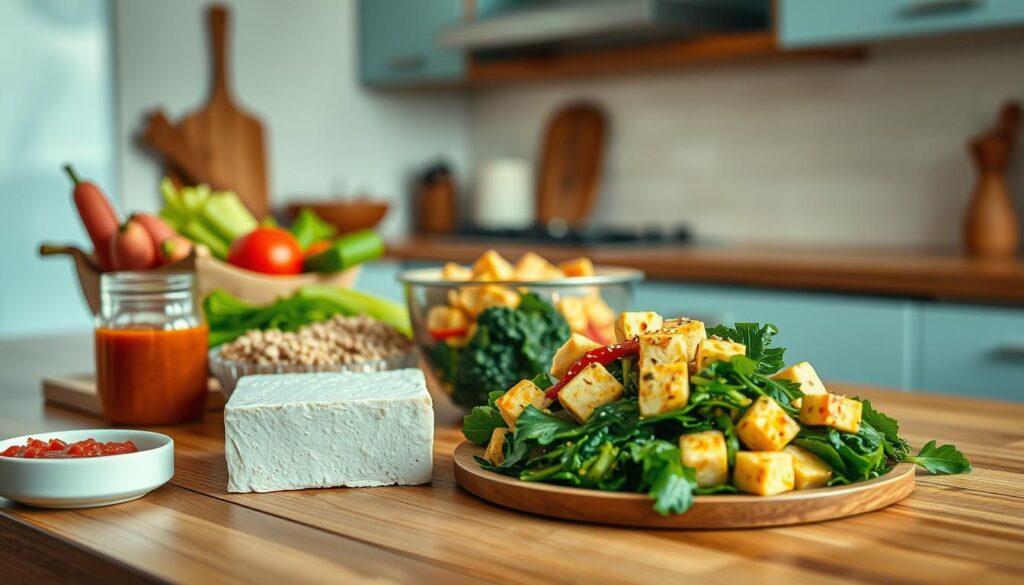
Nutritionally, it’s a powerhouse. Each serving delivers complete amino acids and absorbs flavors like a sponge—perfect for marinating batches ahead. Studies show soy-based diets support sustained energy, which explains why my roasted garlic cubes keep me fueled through back-to-back recipe tests.
Cost and convenience shine too. Compared to specialty meats, it’s budget-friendly and lasts all week when prepped right. I’ll often bake two trays: one for sesame-ginger bowls, another for Mediterranean wraps. Both stay fresh for days without turning mushy.
The real magic? How it adapts. From peanut-lime dressings to smoky paprika rubs, this ingredient plays well with global flavors. One reader transformed her routine by adding crispy cubes to pre-chopped veggies—“It’s become my 10-minute lunch assembly line,” she told me.
When life gets chaotic, having ready-to-go plant protein means fewer takeout temptations. Next, we’ll explore how to turn these benefits into mouthwatering recipes that fit your schedule.
high protein lunch prep tofu: Recipe Fundamentals
Mastering plant-based meals starts with nailing the basics—let’s break down the building blocks. One client confessed, “I used to dread working with it until I learned these three non-negotiables.” Here’s how to create satisfying dishes that hold up all week.
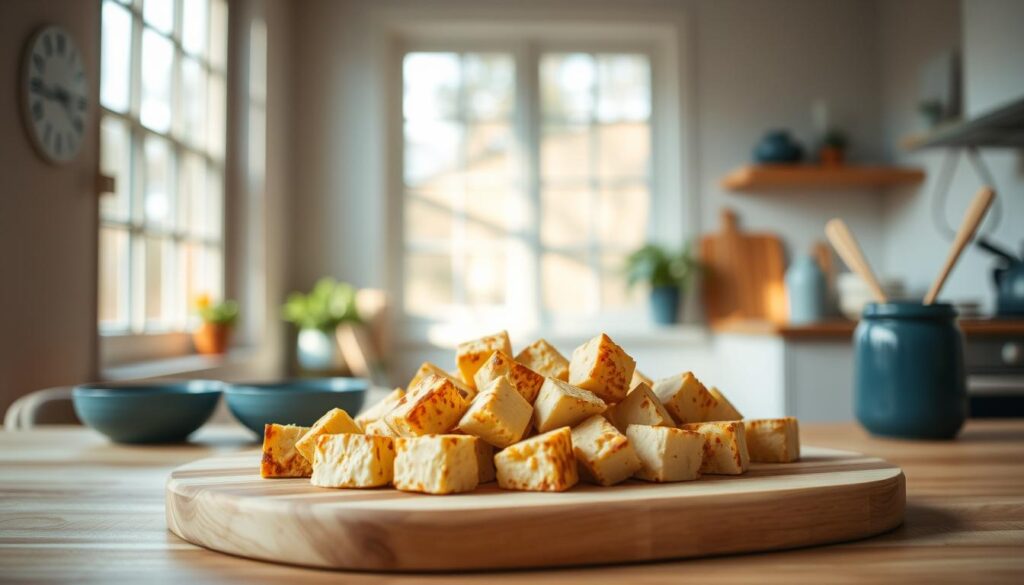
Start with firm varieties. Their lower moisture content ensures better texture after cooking. Press your block for 15 minutes using a heavy pan—this simple step makes all the difference in absorbing flavors. Cut into ¾-inch cubes; uniform sizing prevents some pieces from drying out while others stay soggy.
Coating matters. Whisk together 2 tablespoons soy sauce with 1 teaspoon cornstarch—this combo creates a caramelized crust when baked. “The cornstarch trick changed everything,” a reader recently shared. Toss cubes gently to avoid breaking them, then spread on a parchment-lined sheet.
Bake at 400°F for 20-25 minutes, flipping halfway. This delivers golden edges without constant monitoring. Pair with jasmine rice and quick-pickled veggies for balanced meals. A recent study found meals combining grains and plant proteins keep energy levels steadier than carb-heavy options.
Remember: Great results come from technique, not complexity. As I tell my cooking class students, “Your sheet pan and basic pantry staples are all you need.” Nail these fundamentals, and you’ll build endless variations effortlessly.
Key Ingredients and Flavor Profiles
Building memorable meals starts with understanding your flavor toolkit. Every component plays a distinct role—like actors in a well-choreographed play. Let’s explore how simple elements create showstopping dishes that keep your taste buds engaged all week.
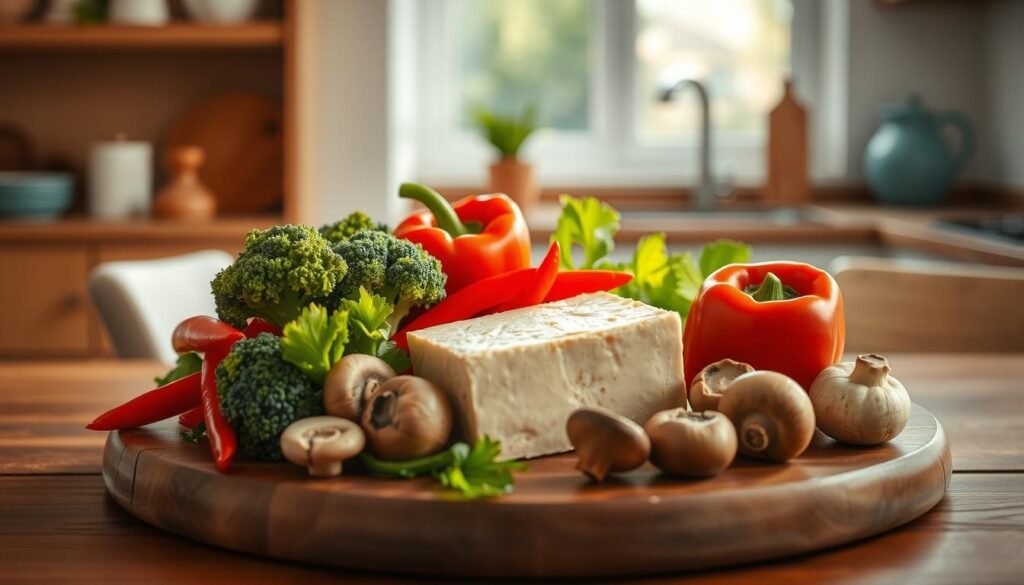
The Foundation: Texture and Balance
Firm varieties act as the protein anchor, holding marinades while maintaining structure. A client once joked, “It’s the quiet supporter that lets veggies and sauces shine.” Pair it with crisp greens like bok choy or shredded cabbage for contrast. These vegetables add freshness and crunch, preventing meals from feeling heavy.
Mixed greens bring visual appeal and nutrients. Think rainbow carrots or purple cabbage—their colors signal diverse antioxidants. For quick swaps, try snap peas or bell peppers if bok choy isn’t available.
Sauces That Sing
Peanut sauce transforms basic bowls into crave-worthy creations. Whisk natural peanut butter with lime juice, soy sauce, and a touch of maple syrup. This combo delivers creaminess without overpowering other ingredients. “I’ve converted three coworkers using that sauce,” a reader recently shared.
Asian spices like ginger and chili flakes add warmth. Toasted sesame seeds or crushed peanuts provide finishing texture. Balance is key—too much heat can mask the delicate nutty undertones.
| Ingredient | Role | Substitution |
|---|---|---|
| Firm tofu | Protein base | Tempeh |
| Bok choy | Crunch factor | Kale |
| Peanut sauce | Creamy binder | Tahini dressing |
| Ginger | Brightness | Lemongrass |
Quality matters—opt for organic vegetables and minimally processed peanut butter. One secret? Taste your sauce before tossing everything together. Adjust ratios until it makes your eyes light up. That’s when you know you’ve nailed the harmony.
Prepping and Cooking Your Tofu
Ever pulled a soggy block from your fridge and wondered where things went wrong? Let’s fix that. Proper technique turns this blank slate into golden, crave-worthy bites—no culinary degree required.
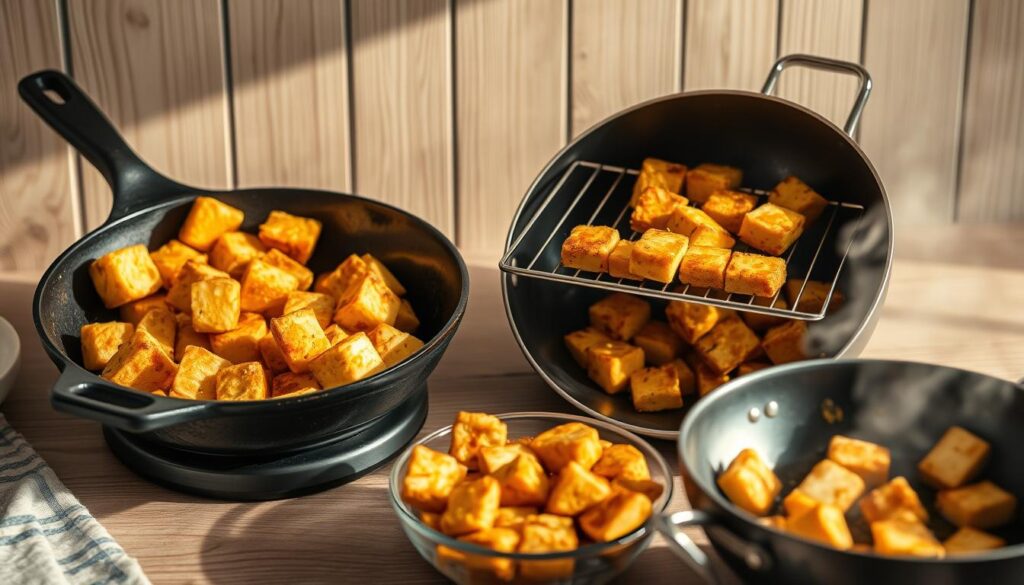
Pressing, Cubing, and Marinating Techniques
Start with firm tofu. Wrap it in a clean kitchen towel, then place a heavy skillet on top for 15 minutes. “Skipping this step is like building a house on sand—it’ll crumble,” says a meal prep client who learned the hard way.
Slice into ¾-inch cubes—uniform size ensures even browning. For marinades, whisk together 2 tablespoons soy sauce, 1 teaspoon rice vinegar, and a dash of chili flakes. Toss gently. Let sit 10 minutes while your oven preheats.
Baking, Air-Frying, and Stir-Frying Methods
Baking delivers hands-off crispiness: 400°F for 20-25 minutes, flipping once. Add a teaspoon of melted butter to the marinade for golden edges. Air-frying? 375°F for 12-15 minutes shakes out restaurant-quality texture fast.
For stir-fries, pat cubes dry first. Sear in hot oil 2-3 minutes per side. A reader tip: “Mix miso paste with cornstarch before tossing—it creates a caramelized crust that sticks!”
| Method | Time | Texture |
|---|---|---|
| Baking | 20-25 mins | Crispy exterior |
| Air-Frying | 12-15 mins | Ultra-crunchy |
| Stir-Frying | 5-7 mins | Chewy center |
If cubes feel rubbery, they’re undercooked—toss back in the oven. Too dry? Drizzle with sauce before storing. Remember: Great meal prep hinges on nailing these basics first.
Asian-Inspired Tofu Recipes for Meal Prep
Bowls become your week’s culinary canvas when you embrace Asian flavor traditions. One reader nailed it: “These combos make my work lunches feel like takeout—without the 3 p.m. energy crash.” Let’s explore two foundational formats that keep things fresh.
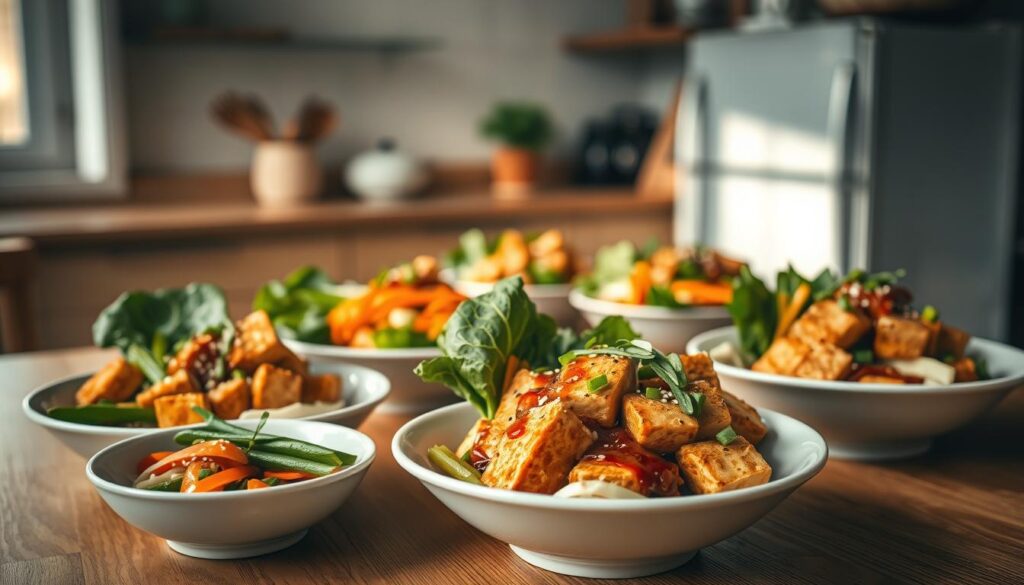
Buddha Bowl Blueprint
Start with a base of jasmine or brown rice—it’s sturdy enough to hold sauces without turning mushy. Top with marinated cubes (try soy-garlic glaze) and quick-pickled veggies. A client’s genius hack: “I prep rainbow slaw separately, then toss it in rice vinegar right before assembling.”
- Swap grains: Quinoa or soba noodles work for gluten-free needs
- Layer textures: Crispy baked pieces + steamed bok choy + creamy avocado
- Dress smart: Whisk peanut butter with lime and chili for instant richness
Poke & Stir-Fry Twists
For grab-and-go days, mimic Hawaiian poke bowls. Cube seasoned pieces and pair with edamame, mango slices, and sesame seeds. Pro tip: Use frozen shelled edamame—thaws by lunchtime!
Stir-fries shine for using leftover veggies. Toss pre-chopped bell peppers and snap peas in hot sesame oil, then add pre-cooked chunks. A recent favorite combo:
| Component | Prep Ahead | Flavor Boost |
|---|---|---|
| Rice | Cook Sunday | Furikake seasoning |
| Veggies | Chop Wednesday | Quick ginger sauté |
| Sauce | Store 3 days | Miso-tahini blend |
Remember: These templates adapt to what’s in your fridge. As I tell my meal prep students, “The best recipes are the ones that work with your schedule—not against it.”
Nutritional Benefits of Plant-Based Protein
What if your lunch could power your afternoon without weighing you down? Soy-based options deliver a unique combo: complete amino acids plus gut-friendly fiber. A client once confessed, “I thought plant meals meant constant snacking—until I tried proper portioning.”
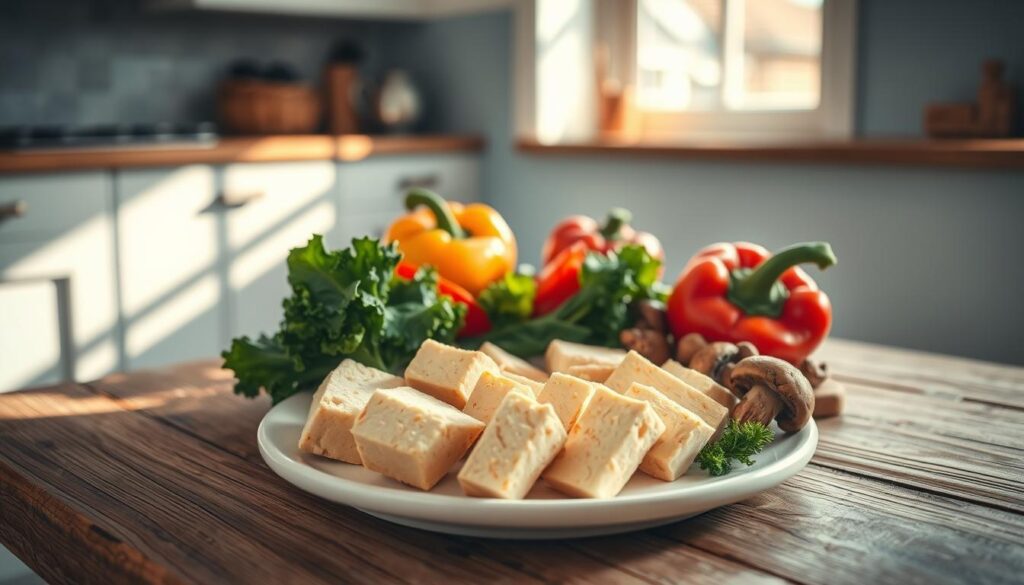
Soybeans pack 10g of protein per half-cup—equal to chicken breast but with zero cholesterol. Unlike animal sources, they offer 2g of fiber per serving. This duo keeps blood sugar steady, making afternoon crashes less likely. Research shows diets rich in soy may reduce inflammation, too.
| Protein Source | Protein (per 100g) | Fiber | Healthy Fats |
|---|---|---|---|
| Tofu | 8g | 1g | 4g |
| Chicken | 27g | 0g | 3g |
| Lentils | 9g | 8g | 0.4g |
Don’t fear the fat—soy contains omega-3s that support brain health. Pair it with vitamin C-rich veggies like bell peppers to boost iron absorption. One myth I often debunk: “Plant proteins aren’t complete.” Soy actually contains all nine essential amino acids your body can’t make.
For those balancing fitness goals, these meals aid muscle repair without excess calories. My trick? Add sesame seeds to roasted cubes—they provide zinc for immune support. Simple swaps create meals that nourish and satisfy.
Customizing Your Tofu Meal: Variations and Ingredient Swaps
Your meal prep shouldn’t feel like eating leftovers on repeat. One reader nailed it: “Swapping just two ingredients each week keeps my taste buds guessing!” The beauty of plant-based cooking lies in its flexibility—let’s make your kitchen a playground.
Vegetable and Grain Substitutions
Rotate your base grains like you’d change workout routines. Jasmine rice pairs beautifully with Thai-inspired dishes, while nutty quinoa holds up to Mediterranean flavors. A client swears by mixing leftover farro with roasted cubes: “It’s like a whole new meal without extra effort.”
Seasonal veggies keep things fresh. Swap bok choy for zucchini in summer, or try roasted Brussels sprouts in fall. Keep texture in mind—pair crisp snap peas with creamy sauces, or sautéed mushrooms with tangy dressings.
| Grain | Flavor Pairing | Cook Time |
|---|---|---|
| Brown rice | Sesame-ginger | 35 mins |
| Quinoa | Lemon-tahini | 15 mins |
| Couscous | Harissa-spiced | 5 mins |
Alternative Sauces for New Flavors
Your sauce jar holds endless possibilities. Replace peanut butter with sunflower seed butter for nut-free options, or blend silken cubes into miso dressing for extra creaminess. “Adding a dash of chili crisp transformed my basic bowl,” shared a home cook.
Balance matters. Creamy sauces need acidity—try lime juice or rice vinegar. For heat lovers, mix gochujang with maple syrup. Don’t forget healthy fats: a drizzle of toasted sesame oil adds richness without overpowering.
Quick and Easy Meal Prep Tips for Busy Professionals
What’s the fastest way to turn Sunday chaos into weekday ease? It starts with treating your kitchen like a well-oiled machine. “Multitasking is my secret weapon,” shares a client who preps five days’ worth of meals in 90 minutes. Here’s how to streamline your routine without sacrificing flavor.
Strategic Cooking Order
Start with the oven—preheat it first. While it warms, chop veggies and press your soy-based protein. Roast vegetables and bake seasoned cubes simultaneously. This overlapping method saves 20 minutes compared to cooking components separately.
Group tasks by appliance usage. Boil grains while sautéing greens, then use the same pan for sauces. A reader tip: “I write my cooking order on a sticky note—prevents backtracking.”
“Batch-cooking sauces on Sunday transformed my week. I spend 10 minutes whisking peanut-lime dressing instead of daily prep.”
Portion meals immediately after cooking. Use divided containers to separate crisp elements like shredded cabbage from saucy components. For inspiration, explore these batch-friendly recipes that maintain texture for days.
Time-Saving Hacks
- Label containers with reheating instructions
- Store dressings in squeeze bottles for mess-free assembly
- Freeze pre-portioned smoothie packs using leftover fruit
One game-changer? Repurpose ingredients across meals. Roasted sweet potatoes work in grain bowls and breakfast scrambles. Discover more nutrient-dense dishes that adapt to your schedule.
Remember: Effective planning beats perfection. As I tell my cooking class students, “Your goal isn’t Instagram-worthy containers—it’s reclaiming your weeknights.”
Storing and Reheating Your Tofu Dishes
Ever opened your lunch container to find once-crispy cubes swimming in sauce? Let’s fix that. Proper storage turns meal prep into fresh-tasting meals all week. “Separate components are non-negotiable,” says a mom who transformed her family’s routine. Here’s how to keep textures intact and flavors bright.
Start with airtight glass containers—they prevent fridge odors from seeping in. Store sauces in small jars or silicone cups. For Buddha bowls, layer rice at the bottom, then veggies, with marinated pieces on top. A reader swears by this method: “My sesame-ginger bowls taste day-one fresh thanks to divided containers.”
Reheat smartly. Use the oven at 375°F for 8-10 minutes to revive crispiness. Microwave fans? Place a damp paper towel over rice to lock in moisture. Toss soy-based cubes with a teaspoon of water before microwaving 45 seconds—steam keeps them tender.
| Component | Storage Time | Reheating Tip |
|---|---|---|
| Cooked rice | 4 days | Add 1 tsp water before microwaving |
| Marinated pieces | 5 days | Oven at 375°F for crispness |
| Chopped veggies | 3 days | Keep raw for crunch |
Avoid common mistakes: stacking warm ingredients (they create condensation) or freezing dressed salads (they turn mushy). For fiber retention, reheat greens lightly—overcooking destroys nutrients. One pro tip? Portion sauces in reusable squeeze bottles for mess-free assembly.
Remember: Your fridge is your ally. With these strategies, even Thursday’s meal tastes like it just left the oven. Now go conquer your week—one crispy bite at a time.
Incorporating Tofu into a Balanced Weekly Meal Plan
Does your weekly meal routine feel like a puzzle missing key pieces? Let’s solve it. A sustainable plan balances flavor, nutrition, and practicality—no rigid rules required. Start by designating two prep days: one for batch-cooking grains and marinating soy-based staples, another for assembling grab-and-go containers.
Strategic Framework for Success
Map meals around three core components: plant-based protein sources, fiber-rich veggies, and complex carbs. A client shared her breakthrough: “When I prep cubed pieces separately, I mix them into stir-fries or salads without monotony.” Use this flexible approach to avoid burnout.
| Day | Meal | Key Components |
|---|---|---|
| Monday | Buddha Bowl | Marinated cubes, quinoa, shredded cabbage |
| Wednesday | Stir-Fry | Leftover pieces, snap peas, brown rice |
| Friday | Wrap | Crumbled seasoned soy, spinach, hummus |
Portion proteins first—aim for ½ cup per serving. Store sauces in squeeze bottles to control quantities. For families, double batches of roasted veggies and grains on Sunday. Repurpose extras into next-day scrambles or fried rice.
Grocery shopping becomes efficient with a categorized list: fresh produce, pantry staples, and flavor boosters. Explore these vegan meal prep strategies for inspiration. Remember: Consistency thrives on simplicity. Rotate two marinades weekly, and let seasonal veggies dictate variety.
Your turn: Adjust portions based on activity levels, and celebrate small wins. One reader’s success? “I now spend 20 minutes daily assembling meals instead of stressing.” That’s the real recipe for lasting change.
Let’s celebrate how far your meal prep game has come! You’ve discovered how this soy superstar delivers flavor flexibility and complete nutrition in minutes. Whether you’re baking golden cubes or tossing them with zesty sauces, these recipes prove plant-based eating doesn’t mean sacrificing satisfaction.
Remember: Success lies in simplicity. Pressing techniques and smart storage keep textures perfect, while rotating veggies and grains prevents taste bud burnout. One reader shared, “Swapping peanut sauce for lemon-tahini made my family forget we’re eating meatless!”
Your next step? Grab those divided containers and batch-roast a tray this Sunday. Share your creations with #PrepistryEats—we’d love to see your spicy stir-fries or Buddha bowl masterpieces. Hungry for more? Explore our recipe hub for endless inspiration.
Here’s to lunches that fuel your hustle without draining your time. You’ve got this!
Spicy Pineapple Tofu Power Bowls
A vibrant and flavorful vegetarian dish featuring crispy tofu, sweet pineapple, and a medley of fresh vegetables, all tossed in a spicy marinade and served over your choice of grain.
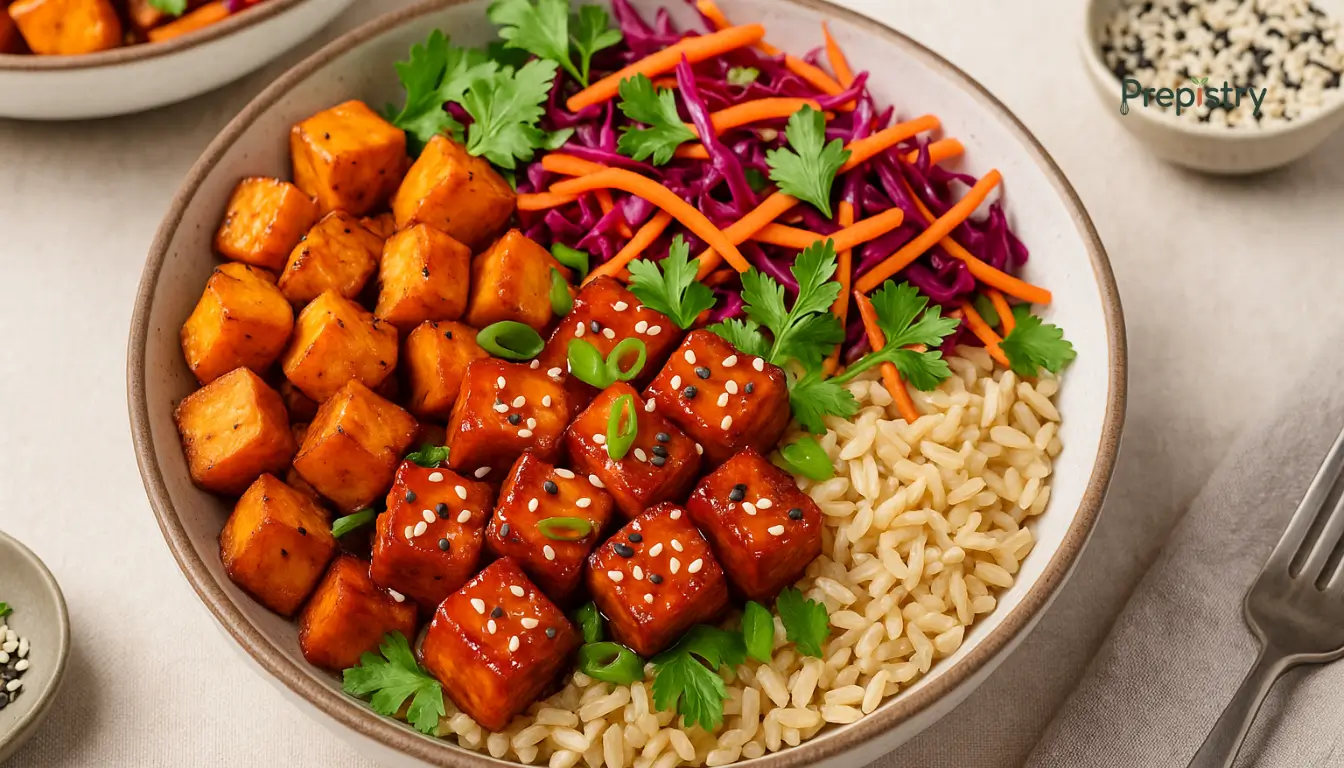
Nutrition Information
Equipment Needed
- Baking sheet
- Mixing bowls
- Whisk
- Knife
- Cutting board
- Parchment paper
Ingredients
-
1 block (14 oz) extra-firm tofu, pressed and cubed
-
2 cups fresh pineapple chunks
-
1 red bell pepper, sliced
-
1 yellow bell pepper, sliced
-
1 cup green beans, trimmed
-
2 tablespoons olive oil
-
2 tablespoons soy sauce
-
1 tablespoon sriracha
-
1 tablespoon honey or maple syrup
-
1 teaspoon grated fresh ginger
-
2 cloves garlic, minced
-
1 tablespoon sesame seeds (optional)
-
Cooked rice or quinoa, for serving
Instructions
Recipe Video
Spicy Pineapple Tofu Power Bowls Recipe
Learn how to make Spicy Pineapple Tofu Power Bowls, a delicious and healthy vegetarian meal perfect for any day of the week.

